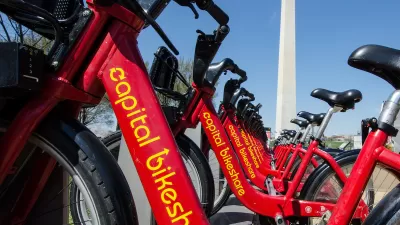Research reveals that shared bikes and scooters are often a crucial lifeline for low-income workers, signaling a need to include micromobility in the larger public transit conversation.

A study of survey data from the United States, Australia, and New Zealand sheds light on how low-income people use shared micromobility services, indicating an opportunity for cities to improve transportation services for the workers who need them most.
Kea Wilson outlines the findings in Streetsblog USA, writing, “Participants in the Lime Access program, which grants discounts of around ‘70 or 80 percent’ to riders who qualify, were significantly more likely to list essential reasons like ‘shopping’ for groceries (35 percent) and ‘commuting’ (31 percent) than non-Access riders, 11 and 21 percent of whom rode to complete errands or go to work, respectively.”
The study found that lower-income users were very unlikely to use shared mobility for non-essential reasons. “And a whopping 44 percent of their trips connected to a traditional transit ride, compared to just 23 percent of people who paid full price.”
As Wilson notes, “Perhaps the most surprising findings, though, were riders' qualitative responses about what micromobility meant to them, and how their lives were made better by having access to affordable ways to get around without a car.” According to Calvin Thigpen, director of policy research for Lime and co-author of the report, “People are using this to get around for pivotal trips; they are heavy, often daily users.”
However, most U.S. bike share systems are not subsidized by public funding, meaning any equity programs cut into the operators’ profit margins. Planetizen recently covered Houston BCycle’s decision to shut down that program due to funding problems. For Thigpen and other advocates, this signals a need to support and fund shared mobility programs as an integral component of an accessible, comprehensive public transit system.
FULL STORY: Study: How Low-Income People Really Use Micromobility

Alabama: Trump Terminates Settlements for Black Communities Harmed By Raw Sewage
Trump deemed the landmark civil rights agreement “illegal DEI and environmental justice policy.”

Planetizen Federal Action Tracker
A weekly monitor of how Trump’s orders and actions are impacting planners and planning in America.

The 120 Year Old Tiny Home Villages That Sheltered San Francisco’s Earthquake Refugees
More than a century ago, San Francisco mobilized to house thousands of residents displaced by the 1906 earthquake. Could their strategy offer a model for the present?

In Both Crashes and Crime, Public Transportation is Far Safer than Driving
Contrary to popular assumptions, public transportation has far lower crash and crime rates than automobile travel. For safer communities, improve and encourage transit travel.

Report: Zoning Reforms Should Complement Nashville’s Ambitious Transit Plan
Without reform, restrictive zoning codes will limit the impact of the city’s planned transit expansion and could exclude some of the residents who depend on transit the most.

Judge Orders Release of Frozen IRA, IIJA Funding
The decision is a victory for environmental groups who charged that freezing funds for critical infrastructure and disaster response programs caused “real and irreparable harm” to communities.
Urban Design for Planners 1: Software Tools
This six-course series explores essential urban design concepts using open source software and equips planners with the tools they need to participate fully in the urban design process.
Planning for Universal Design
Learn the tools for implementing Universal Design in planning regulations.
Clanton & Associates, Inc.
Jessamine County Fiscal Court
Institute for Housing and Urban Development Studies (IHS)
City of Grandview
Harvard GSD Executive Education
Toledo-Lucas County Plan Commissions
Salt Lake City
NYU Wagner Graduate School of Public Service





























